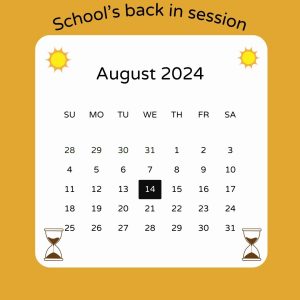English learners persevere at Ventura High School
Every Wednesday at lunch, English Learner Support Teacher Emily Bradvica Downard holds “Simon says” sessions for English learners in room 50. At the sessions students guess the English word for another student’s action. Photo by: Alejandro Hernandez
April 25, 2022
English learners make up over 16 percent of the student body, but how are they accommodated?
La version en español de este artículo se puede leer aquí.
Ventura High School students are separated into different groups based on their English Language Acquisition Status (ELAS), which is determined by English fluency. These groups are English Only (EO), Initial Fluent English Proficient (IFEP), Reclassified Fluent English Proficient (RFEP), English Learner (EL) and To Be Determined (TBD). Among these classifications, EL is considered the lowest in fluency.
The California Department of Education (CDE) defines EL as, “A student who enrolls in a California school beginning in any grade level, transitional kindergarten through grade twelve, has a language other than English identified on the Home Language Survey, and upon assessment, obtained a level of English proficiency that indicates programs and services are necessary.”
According to the CDE Reporting Office, 365 out of 2,165 VHS students are classified as EL (as of the 2021-2022 school year). This means that 16.86 percent of the student population is considered to be an EL.
One of those ELs is senior Karley Legazpi, who moved to the U.S. in 2019. Legazpi said, “School is very difficult without knowing English. I would rate my English skills a three out of 10. You can have friends that don’t speak English but they can’t help you because they don’t know English themselves. It’s also difficult to make bilingual friends, usually, the bilingual friends you do have are your cousin or something like that. You don’t really have anyone, translators help you in class but they aren’t your friend. All they do is translate.”
According to the California Education Code Section 48985, if 15 percent or more of students at a public school speak a primary language other than English, all school documents must be written in both languages. VHS must follow this rule as 31.78 percent of students speak Spanish as a primary language.
Legazpi said, “All of my classes are in English. I was in a math class for a week with Mr. Rivera, who speaks Spanish, but they changed my schedule. Now I only have classes with non-Spanish speaking teachers. They try to find classmates who are bilingual and can translate on their behalf. Sometimes teachers would give me work printed in Spanish so that I don’t have to translate.”
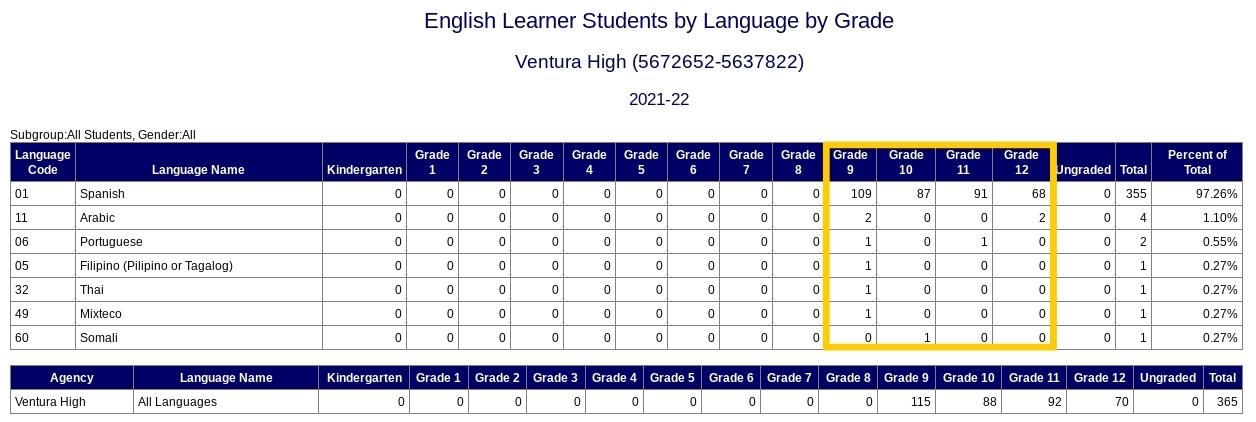
EO students are people who only speak English. IFEP students are those who have generally well-developed English language skills, but may occasionally need assistance with the less familiar subject matter. RFEP students are former EL students who achieved English fluency, eliminating the need for support and allowing for reclassification. TBD students have not been verified in their English language skills.
English Learner Support teacher Emily Bradvica Downard said, “An ELL student can get reclassified to NOT an ELL anymore by first earning a four on the ELPAC exam. Then a teacher, counselor [or] administration committee looks at each student’s current Reading Lexile score, their grades in their classes (especially their core classes like English, History, Math, etc.), if they passed the English SBAC overall exam, and other data points to determine if they’re ready to be reclassified. Finally, parents are informed and decide if they agree with the reclassification or not.”
Junior Carlos Ayala, who is an EL, said, “I really like school. I am doing well in terms of my grades and activities. I don’t have a lot of homework and I was assigned several classes where Spanish is spoken to make it easier for me in school as I learn English. I have received a lot of help from various teachers and my counselor to be able to take classes and to help to make my work easier.”
Senior Paola Chavez said, “When I didn’t speak English in school, it was very frustrating to communicate with my teachers and it was very difficult to make friends because a lot of the time kids would make fun of me without knowing.”
Bradvica Downard said, “Each designated EL student has a different story and situation. Some EL students were born in the U.S. and have gone to school here since elementary school. Some have recently moved here from another country.”
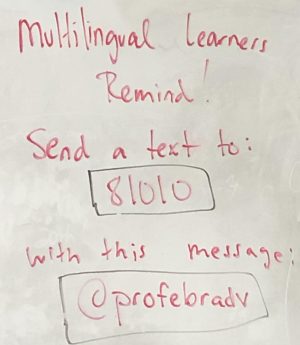
Bradvica Downard and EL counselor Francisco Castillo offer support resources for ELs. Bradvica Downard said, “Here at VHS, any ELL or reclassified ELL student can come to Room 50 to see Mr. Castillo or I with any questions, concerns and or to get academic or emotional support. We are the VHS ELL support team! There is a team of support at the district level as well. I help ELLs by meeting one on one or in small groups with them, giving academic support, observing classes, supporting their teachers, making phone calls home, meeting with families, celebrating their successes, providing test prep (ELPAC), connecting ELLS with other resources (ASSETS, tutoring, therapists, etc.), connecting them to opportunities (field trips, college info, job info, etc.) and much more.”
ELPAC stands for “English Language Proficiency Assessments for California.” It is an exam administered to ELs to determine their English language fluency. There are different kinds of ELPAC exams for different EL scenarios.
The “Initial ELPAC” exam is a test designed to identify new ELs. The “Summative ELPAC” is an annual exam given to ELs to determine their English language progress and to identify their status as an EL. The “Alternate ELPAC” exam is given to students with severe cognitive disabilities but is otherwise identical in purpose to other ELPAC exams.
According to the CDE Reporting Office, nine VHS students took the initial ELPAC exam during the 2020-2021 school year. There is no available information on the students’ performance. 253 students took the summative ELPAC exam during the 2020-2021 school year, with 22.46 percent of test-takers receiving the highest level of four (well-developed). 40.68 percent of test-takers received a level three score (moderately developed), 29.66 percent received a level two (somewhat developed) and 7.2 percent received the lowest score of one (minimally developed).
Legazpi said, “The school does give enough help [to EL] but many students don’t seek help. I think that the school should have classes like history or math in Spanish. Even if it is just one class of each subject where they can put everyone who doesn’t speak English.”
Chavez said, “I think something VUSD can do better to help English learners is making them feel more comfortable, I know with my experience I felt kind of embarrassed to be pulled out of class to a different teacher because I couldn’t speak English so if there’s a way to make kids feel better about that I think it would be beneficial.”
According to the CDE, California has the largest EL student population in the U.S, with over one million people between kindergarten and twelfth grade. Another million are RFEP students.
During the 2020-2021 school year, the four-year cohort graduation rate among ELs was 67.1 percent. This was lower than the 86.1 percent graduation rate among non-ELs. According to the CDE, “The four-year cohort graduation rate is calculated as the percent of students who graduate high school with a traditional high school diploma within four years from the time they enter ninth grade.”
Legazpi said, “I would recommend that [ELs] don’t stay silent. I used to be silent and I ended up with all Fs. They should try to seek help from a teacher or counselor so they can best help you understand your classes.”



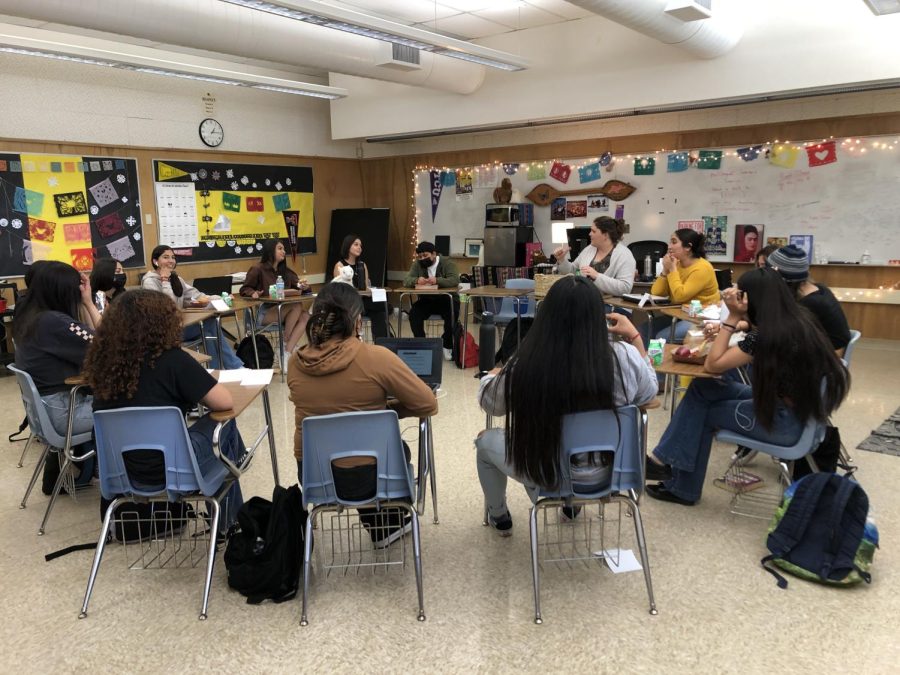


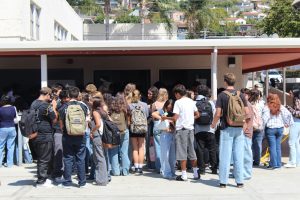

![Lindsay Guzik, new assistant principal said, "I am settling in [at VHS] pretty well. I know a lot of the students, so that makes it a little bit easier coming from Cabrillo, and it's been nice to see them all grown up." Photo by: Abraham Kassa](https://thecougarpress.org/wp-content/uploads/2025/09/IMG_9728-300x200.jpg)
